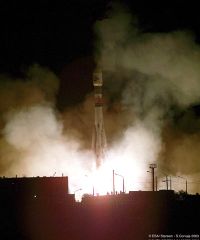Difference between revisions of "Soyuz-Fregat rocket"
(cannot link inside a link) |
|||
| (3 intermediate revisions by 3 users not shown) | |||
| Line 22: | Line 22: | ||
* [http://www.starsem.com/ Starsem - Soyuz marketing company] | * [http://www.starsem.com/ Starsem - Soyuz marketing company] | ||
| − | [[category: | + | [[category:Exploration Transport Systems]] |
Latest revision as of 16:23, 17 December 2018
Overview
The Soyuz-Fregat launch vehicle is part of the overall Soyuz family, based on the original R-7 used to launch Sputnik-1 the world's first artificial launch vehicle. It therefore has the longest flight heritage of any orbital launch vehicle.
Soyuz-Fregat is designed for cost-effective solutions on missions that require medium and high altitude Earth orbits. Soyuz-Fregat uses the basic Soyuz vehicle (often associated with delivering supplies to the International Space Station) that composes of a lower/first stage (with 4 booster rockets), a central/second stage.
The Fregat is an upper stage which can be placed on the top of a Soyuz core vehicle to create the Soyuz-Fregat configuration with an upper portion containing the third stage (the Fregat upper stage) and payload. The Mars Express mission used such a rocket to be inserted into Earth orbit before its journey to Mars.
The Fregat stage was originally used for interplanetary missions which were launched on Proton vehicles.
According to the Starsem launch log there have been eleven flights of the Soyuz-Fregat configuration as of April 2007.
The Soyuz-Fregat is well-known for its reliability and high technical standards.
The Soyuz-Fregat launcher version has a 5,000kg payload performance to a 450km circular orbit inclined 51.8 deg, or 4,000 kg to a 1,400 km circular orbit.







